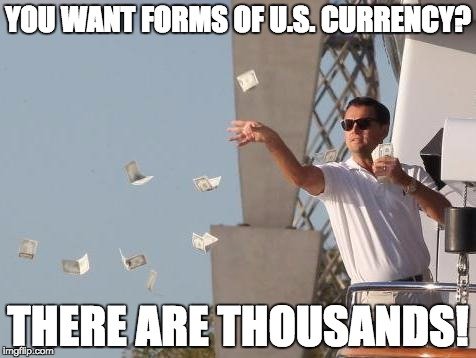Table of Contents (click to expand)
First and foremost, paper money isn’t actually paper at all, but a substrate composed of cotton fiber and linen. The specific ratios of materials may differ between national mints and independent producers
As the old saying goes, “Money makes the world go round,” so whether you’re a capitalist robber baron or a minimum-wage workingman, it’s hard to keep cash off your mind. All around the world, human beings earn, spend and seek money in all of its various forms.
When you open your wallet, it’s always nice to see a thick stack of crisp bills ready to be spent on whatever your heart desires, but at first glance, paper bills don’t seem like the best choice as currency. Normal paper can be easily ripped, spilled on, crumpled, worn down etc., yet around the world, paper money is the popular choice!
This leads to an obvious question…. what kind of material is actually used to make currency?
Short answer: Cotton and linen, but the story doesn’t end there…
The History Of Paper Money
Like so many modern inventions that we take for granted, the first form of paper currency actually originated in China more than 1,000 years ago, during the Tang Dynasty. Folded banknotes were widely used for more than 500 years in that ancient nation, centuries before the trend ever caught on in Europe. Most of these early banknotes were exchange notes or private bills denoting a certain amount of credit, but the purpose was generally the same.
In the United States, paper money first appears in the late 17th century, and the first “dollar bills” were printed about 70 years later.
However, there was very limited regulation or consistency between many of these paper bills, making counterfeiting a rather common problem. Furthermore, the American Revolution was a very uncertain time, and this led to huge fluctuations in the buying power of this currency.
Following that tumultuous time in American history, the government stopped printing paper currency, but banks, individuals and merchants began using the technique and printing their own versions of currency, resulting in hundreds of different forms of currency in the United States by the time the Civil War began.

Realizing the need to standardize the nation’s currency, the government once again stepped in and began printing money in varying denominations, and linked the value of the money to a certain weight in gold, according to the Coinage Act of 1873.
The nation returned to a silver standard in 1934, and then abandoned it in 1963. Many countries around the world have had similarly complicated relationships with paper money and its “actual value”. However, while the history of paper money is interesting, the manufacturing process to produce such incredibly durable bills is even more intriguing.
Also Read: Who Makes Bills And Coins For An Economy, And How Do They Decide The Value Of Each?
Building The Dollar Bill
While every national currency looks slightly different, the standards for production are relatively similar. First and foremost, paper money isn’t actually paper at all, but a substrate composed of cotton fiber and linen. The specific ratios of materials may differ between national mints and independent producers, but most currencies contain roughly 70-95% cotton.
Some of the less common materials in currency are wood fiber, animal glue, aluminum chloride, and melamine formaldehyde resin, among others. This composition gives currency the unique “feel” of paper, while also making it extremely durable and strong.
For example, a normal sheet of paper, made from the cellulose of wood pulp, will break down and begin to tear relatively quickly when it is handled roughly, folded or exposed to the elements.
However, most forms of currency around the world are designed to take a beating without being compromised. Considering that the paper substrate for the currency of more than 100 nations comes from the same company (De La Rue plc from the UK), it is safe to assume that all currency has a bit of toughness to it.
However, the main producer of the “paper” for US currency is the Crane Paper Company, who watermarks and security marks the paper before delivering it to the Treasury Bureau of Engraving and Printing.
More specifically, colored fibers are inserted into the pulp before it is pressed, in order to make counterfeiting even more difficult. You can hold the bills up to light (in the US, every bill except $1) and see these fibers to determine if a bill is legitimate. The bills below do not pass this test…
After arriving in stacks of 20,000 sheets, the paper is recorded and then put through the printing process. Black, green, metallic and color-shifting ink is used during the intaglio printing process to firmly stamp the images on the bill.
The combination of inks in various layers has made counterfeiting these bills an incredibly difficult process, and most other nations in the world have similar anti-counterfeiting measures in place.
The exact “recipe” of most currency is actually a very well-guarded secret, for obvious reasons, since counterfeit currency remains a real problem in many parts of the world.
Clearly, the government spent a lot of time and money coming up with a stain-resistant, tear-resistant and weather-resistant blend of paper and ink in order to ensure that the bills don’t need to be replaced every few years.
In fact, US currency can be folded approximately 4,000 times before it will tear, meaning that most bills can stay in circulation for 4-10 years. $100 bills, which don’t get used quite as often, can have a lifespan of 15 years or more!
Also Read: What Happens To Currency Notes Once They’re Damaged?
The Next Generation?
The United Kingdom, Australia and Canada have taken currency production to the next level by recently releasing rip-proof currency that is made of plastic polymer, instead of cotton fiber. This super-durable currency can be wiped clean, go through a laundry wash cycle or be completely soaked in sweat without showing any signs of wear. These bills are projected to last for far longer and significantly minimize the need for destroying damaged or unusable notes.

So, the next time you come back from an international jaunt and open your wallet, pay close attention to the different colors, designs and sizes of the currency you’re carrying. Also, be happy that paper is made of such tough stuff, making it a lot easier to keep your cash safe! If you’re still struggling to avoid ripping up your bills or lighting them on fire, just move to Australia. Good luck trying to destroy those bills!
Test how well do you know about the material used in printing currency

References (click to expand)
- Robertson, F. (2005). The Aesthetics of Authenticity: Printed Banknotes as Industrial Currency. Technology and Culture, 46(1), 31–50. http://www.jstor.org/stable/40060794 - JSTOR
- The First Printed Currency - 1690. The University of Notre Dame du Lac
- The History of American Currency | U.S. Currency Education Program - www.uscurrency.gov
- Currency | Engraving & Printing. This result comes from www.moneyfactory.gov
